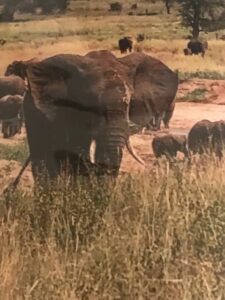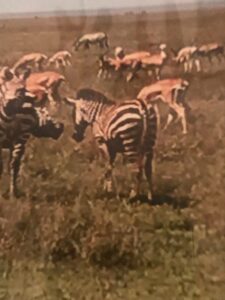ON SAFARI IN TANZANIA, EAST AFRICA by Terri Hirsch
Arriving in the Kilimanjaro International Airport late evening we were met by our safari driver-guide outside the arrival lounge and transferred to our accommodations at the beautiful Kibo Pace Hoel in Arusha Tanzania. Our package featured Arusha Lake Manyara, Serengeti National Park, Tarangire National Park and the Ngorongoro Conservation Area. Arusha is the gateway to some of Tanzania’s most famous attractions: Mt. Kilimanjaro the National Parks and Lodges for Game Drives. Arusha is also known for the precious stone Tanzanite, produced in Arusha and exported worldwide.
After a great breakfast at 6:00 am, our group set out on our first safari to discover East Africa’s legendary wildlife. Our small group was outfitted in a six-seat safari vehicle with pop-up roof allowing for excellent viewing and photography. Our tour leader would rotate each day between our small group of two safari vehicles and tell us fascinating stories of the wildlife. Our sharp-eyed naturalist guides offered insights about the ecosystem
while spotting huge herds of elephants, wildebeest, zebras, towering giraffes and antelope. These huge herds gather to stay in Tarangire National Park until the onset of the rains whey they migrate to good grazing areas.


We departed after breakfast the following day and began the two-hour drive to Lake Manyara National Park, nestled on the basin of the Great Rift Valley. This small National Park has seven distinct habitats which are home to quite a few wildlife. Here we viewed small baboons black-faced monkeys, blue monkeys, impalas, giraffes, buffalo, elephants, waterbuck, bushbuck, zebras and wildebeest- all gathered in groups. Today’s highlight was a large hippo pool with hundreds of hippos. We were allowed to get out of our vehicle to take close-up photographs of these hippos. In the distance were thousands of flamingos on Lake Manyara.
On Tanzania safaris you are not allowed to get out of the safari trucks – this was the one exception. After a late picnic lunch of chicken legs, a small sandwich, water, juice and cake we continued our safari before proceeding to our lodge in Karatu for dinner and overnight. Karatu is one of the seven districts in the Arusha region of Tanzania. The sounds of a bush baby, known as a “Galagos” could be heard during the night.
The following day was a rare opportunity to take a village walk to the Tloma Village-Gibbs Farm to experience different activities of the local Iraqw Tribe. The tour included visiting a school, the Makonde Tribe carving center, the village church with traditional singing and dancing, and an outdoor local coffee grinding station. After returning to the lodge for lunch and a short nap, we continued touring the farmers market before our return to the lodge for dinner and overnight.
Today was the start of two days in the Serengeti National Park’s great migration. At 6:30 am, we proceeded to the Serengeti National Park entrance gate for a two-and half hour drive. Once inside the park we stopped for a picnic lunch where numerous birds could be seen. We were looking forward to enjoying our afternoon game drive en route to Central Serengeti. The annual wildebeest migration through the Serengeti is the largest mass movement of land mammals in the planet. Towering above is Mt. Kilimanjaro, the world’s largest mountain. The Serengeti ecosystem protects the most varied collection of terrestrial (animal) wildlife on earth and is one of the last migratory systems still intact. Not only did we see the wildebeest migration, we encountered baby lions being fed by their mothers, elephants taking baths, zebras, elands, giraffes, waterbucks, families with baby baboons, a tiger and a leopard sleeping in a tree. This was one of the most amazing wildlife spectacles to see.
The last morning our safari departed at 6:39 am with a packed lunch for a four-hour drive to the Ngorongoro Conservation Center. Ngorongoro is technically a caldera, which is an extinct volcano and the largest intact and unbroken caldera in the world. The crater is a microcosm of African scenery with abundant wildlife of more than 20,000 larger animals. Over the years the floor of the crater has become mostly grassland with a lake whose size changes, depending on the rains. We descended 2,000 feet to the base of the Ngorongoro Crater, a UNESCO World Heritage Site. On the lake were colourful flamingos and a variety of other birds – ostriches, cranes and storks. Glimpses of elephant, buffalo, cheetah, hyena, warthog and many antelopes were grazing on this land, Mid-afternoon, we slowly began the climb out of the Crater as we headed for a hot lunch at a lodge overlooking the Crater. After lunch, a two-hour drive took us to our lodge for an overnight and a late dinner. Our wildlife viewing was fascinating and the experience unbeatable on this game drive in the Ngororngoto Crater.
After breakfast, we were driven back to Arusha for last minute shopping at the Cultural Heritage Center. We proceeded to the Kibo Palace Hotel for lunch and a day room to freshen up. In the evening we were transferred to the Kilimanjaro International Airport for our flight back home.


 Chinese Wisdom!
Chinese Wisdom!